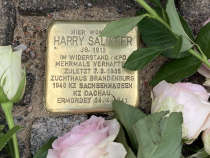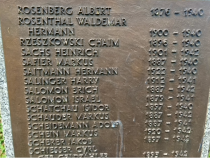Harry Salinger was born in Berlin on December 3, 1912. His parents were Kurt Salinger and Margarethe, née Möhring, born on November 3, 1883. Harry had a younger brother: Heinz, born on December 19, 1913. The family lived in the Forest settlement Fuchsbau 11 in Berlin Lichtenberg.
Harry Salinger was arrested in April 1933 for selling "battle stamps" of the KPD. He was sentenced to six months in prison by a summary court on September 19, 1933. He served this sentence in Plötzensee prison until March 23, 1934.
(The term Kampfmarken (battle stamps) could refer to a 10-penny KPD donation stamp for the Reichstag election of November 6, 1932, with the text "Kampffond der KPD für die Wahl 1932." The stamp depicts a steel mill in the city of Magnitogorsk in the Soviet Union).
After serving the prison sentence, Harry Salinger was free for only one year: on March 7, 1935, he was arrested again and sent to the remand prison.
The co-defendants, the representative Georg Manasse, the bank employee Herbert Wolff, the bricklayer Werner Krause, the plumber Heinz Wegner and the technical draftsman Helmut Paetz had all been in pre-trial detention since March 7, 1935. Harry Salinger was designated as an office boy. All were born between 1912 and 1914, so were between 21 and 23 years old at the time of the arrest.
The indictment of April 10, 1935 accused Harry Salinger and the five other fellow prisoners of having prepared a "highly treasonable enterprise to change the constitution of the Reich by force" in the period from the end of March 34 to the end of February 35.
Harry Salinger (and the five others) had tried to overthrow the government by supporting the KPD (Communist Party of Germany) and the KJVD (Communist Youth League of Germany) - by recruiting members, collecting membership fees, distributing "inflammatory pamphlets". The KPD wanted to bring about Soviet-style rule by force.
Harry admits to being a dyed-in-the-wool communist, but is not a member of the KPD. He had expelled KPD battle stamps and had therefore been sentenced to 6 months in prison by a summary court on 19.9.1933. Various "inflammatory pamphlets" such as "Sozialistischer Sturmtrupp, Das Rote Kabel, Der Funke" and others were found on him. In addition, 16.75 Reichsmark, as proceeds of sold magazines. He also sold winter aid stamps of the KPD.
(Das Rote Kabel was the company newspaper of the revolutionary workers and young workers of the Oberspree power plant. Presumably some members of the resistance group worked at this plant, especially since they lived nearby).
Harry was cashier of the KPD and direct liaison to the co-accused Wagner.
Relations with the other defendants are described - meetings, handing over of writings and money
Finally: "Salinger is to be regarded as an exceptionally active and dangerous functionary of the illegal KPD. He is fully confessed.
The trial was on April 10, 1935, followed by the verdict of the Berlin Superior Court on September 19, 1935:
One of the defendants - Georg Manasse - was acquitted. Harry Salinger and Heinz Wegner were each sentenced to 5 years in prison, the other three defendants to 2 and 3 years in prison.
In the reasoning, reference is made to statements made by criminal assistants, obviously those who observed the six defendants for a year.
The collection of membership dues for the KPD (5 pfennigs per week) from Harry Salinger and their passing on to Wolf is described in detail. The purchase and sale of KPD pamphlets is detailed, and finally the "11 Commandments for the Conduct of Arrestees," whose prefixed motto was: "A communist defends himself not by defending his person but by defending communism and its organizations." All the commandments are listed verbatim in the verdict, consisting of warnings and threats to say anything about the party or its members to the interrogators. Any utterance would be considered treason and "mercilessly judged."
(This writing by the KPD was found during the search of Harry Salinger's apartment in a book entitled "Der Untergang des Judentums." The "Jewish question" is regarded by the author of the book, Otto Heller, as a social, hence economic, problem, the solution of which by socialism in the future will make "retrograde" Zionism superfluous. Published 1933)
Georg Manasse, who was acquitted, was a member of the Zionist workers' movement (Hechaluz) and had wanted to win Harry Salinger, who is described as a half-Jew, for the movement. However, Harry Salinger had been rejected at the medical examination. Therefore, he was not given an "emigrant position in Palestine". Harry Salinger had then several times forced writings of the KPD on Manasse, but he - Manasse - had never paid anything for them.
When the sentence is pronounced, it is pointed out that "here a circle of young people has endeavored to revive the KJVD." Harry Salinger is singled out for special mention because, despite his previous prison sentence, he had "diligently and successfully" disseminated illegal writings. He had wanted to influence "masses" because the high number of "inflammatory writings" had passed from hand to hand and had therefore been read by "wide circles of the population." He had supported the party organization by forwarding the contributions and the proceeds from the sale of the writings. These were two "aggravating grounds for the crime of preparing a highly treasonable enterprise." Above all, Harry Salinger's "scope and time" weigh heavily, as well as the fact that his previous conviction had made no impression on him. The defendant was ... "a fanatical communist, who in his cunning is willing to use any means to subvert the existing order."
Harry Salinger and Heinz Wegner were punished more severely than the other defendants with five years in the penitentiary and sent to Brandenburg prison; the other convicts spent their time in Luckau. All of them were deprived of their civil rights, graduated according to the sentences imposed.
Only Heinz Wegner's prison record has been preserved. His mother had petitioned Hitler for clemency in October 1938. It was rejected in December. At the end of his imprisonment, in February 1940, the prison confirmed that he had worked "willingly and diligently" in his profession as a plumber. A pardon, however, could not be advocated. On January 11, 1940, the Berlin police chief decided that Heinz Wegner would be released from prison but placed under police supervision for four years.
Heinz Wegner was released after serving his sentence. Harry Salinger, on the other hand, was taken to the Sachsenhausen concentration camp. The reason for this is that, according to the Nuremberg Laws, he was half-Jewish. In Sachsenhausen, he was also listed under the prisoner category "Jd”. He was there from April 10 to September 5, 1940 (prisoner number 18361).
On September 6 he was taken to the Dachau concentration camp. On the transport list he is marked with a "Jd" for Jew. He was murdered in Dachau on April 24, 1941.
The urn containing Harry Salinger's ashes was buried at the Weissensee Jewish Cemetery in Berlin. His father had received the urn from Dachau and requested the burial. The grave was given the number 105688; placing a gravestone was not permitted. For several years, however, there has been a lawn in the cemetery with steles engraved with 279 names of victims who were murdered in concentration camps and whose urns are buried here. Harry Salinger is one of them.
Harry's parents, Margarethe and Kurt Salinger, were forced to move out of their apartment in Oberschöneweide (Wilhelminenhofstraße 35). They now lived in the poor Scheunenviertel in Rochstraße, extremely cramped as subtenants (with Ball).
Margarethe died of cancer in the Robert Koch Hospital on August 18, 1944.
Her husband Kurt had to move again after Margarethe's death, to Spandauer Strasse in Berlin Mitte. After the death of Margarethe, who was not Jewish, Kurt no longer had any protection. He perished at the Gendarmenmarkt at the end of April 1945. The actual cause of death is unclear.
Harry's brother Heinz was able to emigrate to Argentina in 1937 and later lived in Berlin again.




